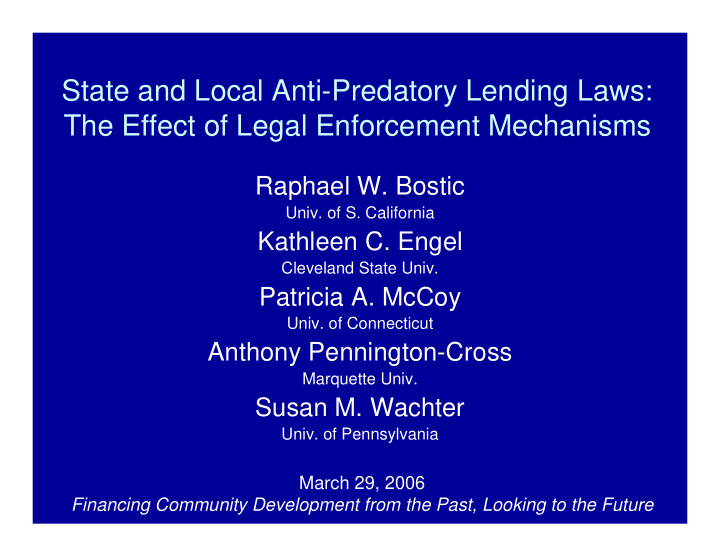



State and Local Anti-Predatory Lending Laws: The Effect of Legal Enforcement Mechanisms Raphael W. Bostic Univ. of S. California Kathleen C. Engel Cleveland State Univ. Patricia A. McCoy Univ. of Connecticut Anthony Pennington-Cross Marquette Univ. Susan M. Wachter Univ. of Pennsylvania March 29, 2006 Financing Community Development from the Past, Looking to the Future
Introduction • Subprime lending’s growth has raised concerns – General performance – Predatory issues • Federal and state governments have responded by enacting laws and regulations for these activities
Anti-Predatory Lending Laws • Type I: HOEPA and Mini-HOEPA laws – If a loan is “high cost,” terms and practices are restricted – “High cost” defined in terms of APR or total points and fees as fraction of loan amount • Type II: Direct restrictions on terms and practices – Prepayment, balloons common targets
Current Research • Do these state-level laws materially impact subprime lending markets? – Follow Harvey and Nigro (2004), Ho, and Pennington-Cross (2006) – Research innovations • New, more comprehensive canvas of laws including Type II laws • Consideration of enforcement details • More refined assessment of nature of specific mechanisms
The New Legal Dataset Dimensions • Coverage – Loan type, two APR triggers, points and fees trigger • Restrictions – Prepayment penalty restrictions, balloon payment restrictions, credit counseling requirements, mandatory arbitration limits • Enforcement mechanisms – Assignee liability, enforcement against originators • Coding: More stringent gets higher score
The New Index • Step 1 – For each subcomponent, rate state against the maximum score • Step 2 – Sum up subcomponents within category • Step 3 – Compare state to average category score • Step 4 – Sum across categories
Index Example: Alabama • Steps 1 and 2 for Coverage Loan type APR I APR II Points 2/4 = 0.5 4/4 = 1 5/5 = 1 4/5 = 0.8 • Coverage score = (0.5+1+1+0.8)/2.1954 = 1.5 • Total across categories Coverage Restrictions Enforcement Total 1.50 1.50 0.40 3.40
The Research Methodology • Use HMDA data • Restrict sample to those loans in counties geographically along a state border – Use a random sample of 225,000 such loans • Include controls for border pair, borrower and location characteristics • Key variables are state anti-predatory lending law characteristics – In effect, total index, category indexes
Empirical Results: Effect of the Laws • In effect variable – Odds of applying for and using subprime loan rises by 5-10 percent – No impact on probability of subprime rejection • Full index variable – Subprime originations rise by 3 percent – No impact on applications – Subprime rejection reduced by 3 percent
Empirical Results: Effect of the Law Components • Coverage index variable – Broader coverage increases odds of applying for (2 percent) and originating a subprime loan (4-5 percent) – Likelihood of being rejected falls (2 percent) • Restrictions index variable – Tighter restrictions reduce odds of applying for (-4 percent) and originating a subprime loan (-1-4 percent) – No impact on likelihood of being rejected • Enforcement index variable – Same pattern as coverage: originations and applications increase, rejections depressed
Conclusions • Anti-predatory lending laws do impact subprime lending activity – Originations and applications increase, denials fall – Suggests that some creditworthy borrowers apply that would not have otherwise • Implication – Properly designed anti-predatory lending laws might actually enhance the subprime lending market
Recommend
More recommend